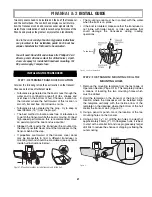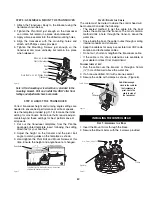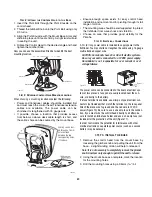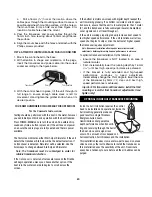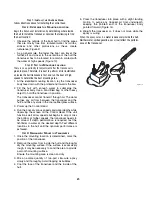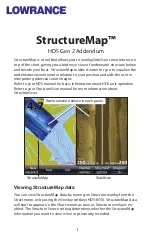
4.
Drill a 16mm (
⁵⁄₈
") hole at the location where the
cables pass through the mounting surface. If access is
possible underneath mounting surface, drill the hole so
the mount base forms a hole cover. See Figure 9 for
location of cable hole under the mount.
5. Pass the transducer and power cables through the
16mm inch hole, leaving about 150mm length above
the surface.
6. Align the mount base with the holes and attach with the
Phillips screws provided.
STEP 6:
ATTACH THE CONTROL HEAD AND PLUG IN CONNECTORS
1.
Mount the control head to the base.
2. With attention to shape and orientation of the plugs,
insert the transducer and power cable into the correct
socket according to the figure below.
3. With the control head in place, tilt the unit through its
full range to ensure enough cable slack is left for
movement. Hand tighten the gimbal knob when at its
desired position.
Y
OUR NEW HUMMINBIRD IS NOW READY FOR OPERATION!
T
EST
& C
OMPLETE
I
NSTALLATION
T
esting should be performed with the boat in the water, however,
you can initially confirm basic operation with the boat trailered.
Press POWER-MENU once to turn the unit on. An audible chirp
sounds any time a button is pressed. If the unit does not power
on, ensure the cable plugs are fully seated and there is power
available.
The first screen indicates either Start-Up or Simulator. If the unit
detects the transducer, Start-Up will be the default selection. If
no transducer is detected, Simulator will be selected. Use the
Arrow keys to change between Start-Up and Simulator.
Note:
The transducer must be submerged in water for
reliable transducer detection.
If the transducer is detected,
after several seconds the Piranha
will begin operation unless you choose another option. If the
boat is in the water sonar data begins to scroll across the
screen.
If the bottom is visible on-screen with digital depth readout the
unit is working properly. If no bottom is visible or erratic opera-
tion occurs, ensure that the unit is in water greater than 1 meter
(3') and the transducer is fully submerged in water. Remember,
sonar signals can not travel through air.
If the unit is working properly, gradually increase boat speed to
test higher speed performance. If the unit functions well at low
speeds but begins to skip or miss the bottom at higher speeds,
the transducer requires adjustment.
Note:
Transducer installation often requires several incremental
adjustments before optimum high-speed performance is achieved.
T
o optimize transducer installation, try the following.
•
Ensure the transducer is NOT located in an area of
turbulent water.
•
First, incrementally lower the running depth by 1.5mm
(
¹⁄₁₆
") until best high-speed perf
ormance is achieved.
•
If the bracket is fully extended and high-speed
performance continues to need adjustment,
incrementally change the Pivot Angle to lower the rear
of the transducer by 3mm (
¹⁄₈
") steps until best high-
speed performance is achieved.
Important:
For transom mount transducers, install the third
mounting screw after final transducer adjustments. Hand
tighten only!
OPTIONAL INSIDE HULL TRANSDUCER MOUNTING
Inside the hull installa
tion requires the control
head to be installed and operational. Inside the
hull mounting generally produces
good results in single thickness
fiberglass-hulled boats.
Humminbird cannot guarantee
depth performance when transmit-
ting and receiving through the hull of
the boat, since some signal loss
occurs. The amount of loss depends on
hull construction, hull thickness and the installation.
This installation requires slow-cure two-part epoxy. Do not use
silicone or any other soft adhesive to install the transducer, as
this material reduces the sensitivity of the unit. Five minute
epoxy has a tendency to cure before all the air bubbles can be
purged.
I-4
Figure 13
T
ransducer
Power
Temperature

